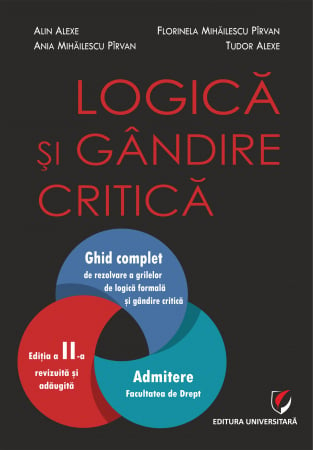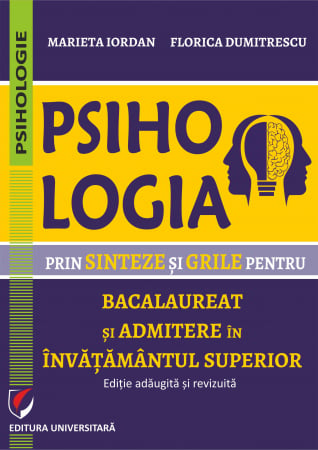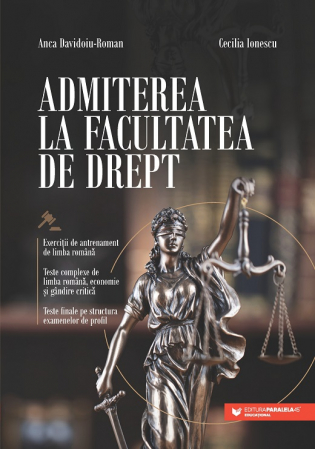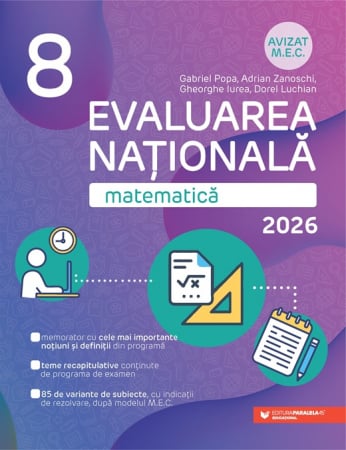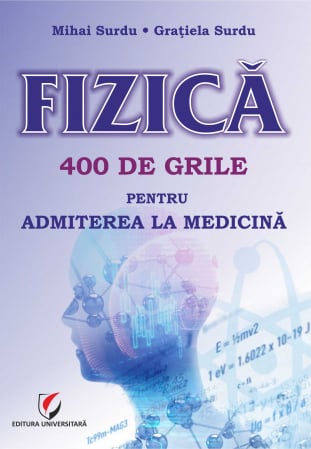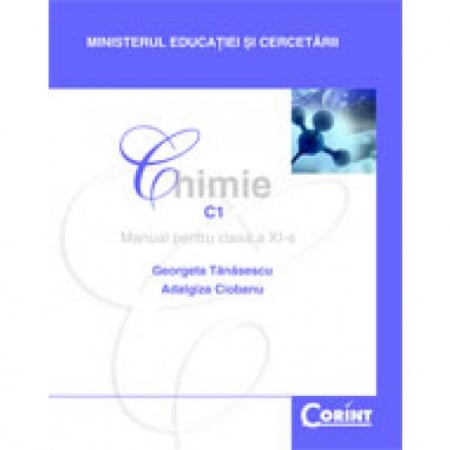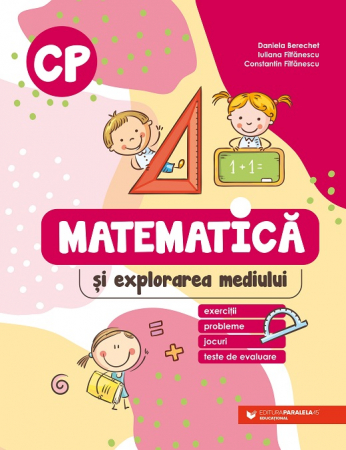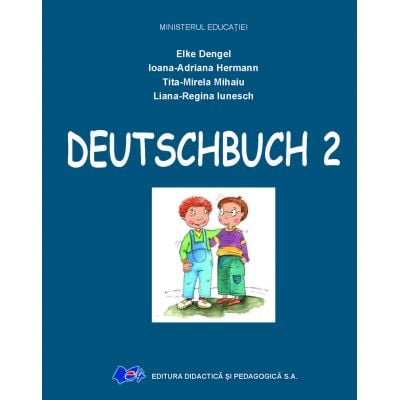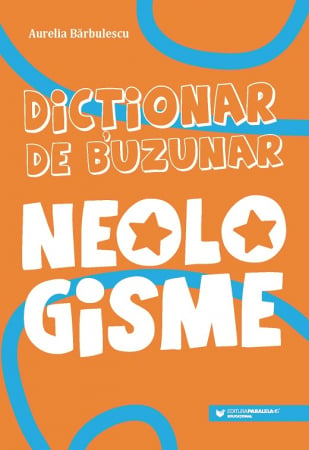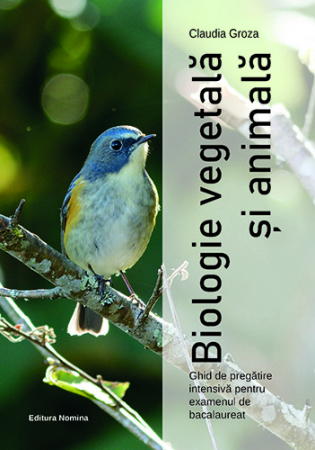Manuscript proposals: [email protected] / 0745 204 115 //// Tracking orders Individuals / Sales: 0745 200 357 / Orders Legal entities: 0721 722 783
6359.png) Logical reasoning. Model exercises with answers and explanations. Admission to Psychology, Law, Police and Gendarmerie Schools, second edition
Logical reasoning. Model exercises with answers and explanations. Admission to Psychology, Law, Police and Gendarmerie Schools, second edition
6359.png)
Publisher: Editura Universitară
Author: Diana Korpos, Dorina Stanescu
Edition: second
Pages: 218
Publisher year: 2025
ISBN: 978-606-28-1891-3
DOI: 10.5682/9786062818913
Product Code:
9786062818913
Do you need help?
0745 200 357
- Authors
- Content
- More details
- Reviews (0)
Foreword/7
I. Psychology admission exercises (Babes-Bolyai University)/9
1. Exercises involving logical relationships, probabilities, matrices, logical-mathematical deductions/9
2. Word-digit coding/33
3. Logical analysis of texts/38
II. Law admission exercises (Babes-Bolyai University)/42
1. String of numbers – rules/42
2. Coded form of words/51
3. Lots of letters and numbers/65
4. Operations/75
5. Statements followed by conclusions/95
6. Logical analysis of texts/113
7. Symbols-rules/122
III. Law admission exercises (University of Bucharest)/128
1. Exercises with terms, categorical sentences, definitions, logical principles, deductive and inductive inferences/128
2. Logical analysis of texts/136
IV. Admission exercises for the School of Police/Gendarmerie (M.A.I)/141
1. Terms/141
2. Categorical sentences/146
3. Deductive inferences /151
3.1. Immediate/151
3.2. Average/155
4. Inductive inferences/160
V. Logico-mathematical deductions/165
Bibliography/218
I. Psychology admission exercises (Babes-Bolyai University)/9
1. Exercises involving logical relationships, probabilities, matrices, logical-mathematical deductions/9
2. Word-digit coding/33
3. Logical analysis of texts/38
II. Law admission exercises (Babes-Bolyai University)/42
1. String of numbers – rules/42
2. Coded form of words/51
3. Lots of letters and numbers/65
4. Operations/75
5. Statements followed by conclusions/95
6. Logical analysis of texts/113
7. Symbols-rules/122
III. Law admission exercises (University of Bucharest)/128
1. Exercises with terms, categorical sentences, definitions, logical principles, deductive and inductive inferences/128
2. Logical analysis of texts/136
IV. Admission exercises for the School of Police/Gendarmerie (M.A.I)/141
1. Terms/141
2. Categorical sentences/146
3. Deductive inferences /151
3.1. Immediate/151
3.2. Average/155
4. Inductive inferences/160
V. Logico-mathematical deductions/165
Bibliography/218
We decided to write this collection to support those who want to take the entrance exam to the Faculty of Psychology and Educational Sciences (Babes-Bolyai University in Cluj-Napoca), the Faculty of Law (Babes-Bolyai University and the University of Bucharest ), the Police School and the Gendarmerie School (Ministry of Internal Affairs), facilitating the solving of exercises focused on logical reasoning through the detailed disclosure of their rules constitution.
Clarity, discipline, critical spirit, the ability to identify the correct arguments, the differentiation between opinion and reasoned explanation, the development of communication skills, represent other cognitive benefits offered by formal logic, in addition to its usefulness in the case of people who intend to take the above-mentioned exams .
Each chapter includes exercises according to the requirements for admission to the previously mentioned faculties. The first chapter includes tasks that involve logical relationships, probabilities, matrices, logical-mathematical deductions, coding words and numbers, as well as logical analysis of texts. The second chapter provides the critical thinking part. The penultimate two chapters include exercises whose content can be found in the school curriculum for the Logic, argumentation and communication discipline for the 9th grade: traditional logical principles, definitions, terms, categorical sentences, immediate deductive inferences, mediated deductive inferences and inductive inferences. The last chapter includes useful exercises especially for Admission to the Faculty of Psychology and Educational Sciences (UBB) and the Faculty of Law (UBB).
In this collection, the emphasis is on practicing and making independent thinking more flexible, not on memorization, as well as on acquiring the ability to transfer information for a quick adaptation to different types of requirements. Its objective is to become the main support for the considerable increase in the chances of those who wish to be admitted to the budget, including through individual study.
The explanations contain all the desirable steps to be followed and can be a substitute for interpersonal interaction, conveying the solutions in a concrete and clear way, regardless of the level of training of the aspirants. We wish them much success!
Clarity, discipline, critical spirit, the ability to identify the correct arguments, the differentiation between opinion and reasoned explanation, the development of communication skills, represent other cognitive benefits offered by formal logic, in addition to its usefulness in the case of people who intend to take the above-mentioned exams .
Each chapter includes exercises according to the requirements for admission to the previously mentioned faculties. The first chapter includes tasks that involve logical relationships, probabilities, matrices, logical-mathematical deductions, coding words and numbers, as well as logical analysis of texts. The second chapter provides the critical thinking part. The penultimate two chapters include exercises whose content can be found in the school curriculum for the Logic, argumentation and communication discipline for the 9th grade: traditional logical principles, definitions, terms, categorical sentences, immediate deductive inferences, mediated deductive inferences and inductive inferences. The last chapter includes useful exercises especially for Admission to the Faculty of Psychology and Educational Sciences (UBB) and the Faculty of Law (UBB).
In this collection, the emphasis is on practicing and making independent thinking more flexible, not on memorization, as well as on acquiring the ability to transfer information for a quick adaptation to different types of requirements. Its objective is to become the main support for the considerable increase in the chances of those who wish to be admitted to the budget, including through individual study.
The explanations contain all the desirable steps to be followed and can be a substitute for interpersonal interaction, conveying the solutions in a concrete and clear way, regardless of the level of training of the aspirants. We wish them much success!
If you want to express your opinion about this product you can add a review.
write a review

![Logical reasoning. Model exercises with answers and explanations. Admission to Psychology, Law, Police and Gendarmerie Schools, second edition [1] Logical reasoning. Model exercises with answers and explanations. Admission to Psychology, Law, Police and Gendarmerie Schools, second edition [1]](https://gomagcdn.ro/domains/editurauniversitara.ro/files/product/large/rationament-logic-modele-de-exercitii-cu-raspunsuri-si-explicatii-culegere-de-admitere-la-psihologie-drept-scolile-de-politie-si-jandarmerie-719870.jpg)
![Logical reasoning. Model exercises with answers and explanations. Admission to Psychology, Law, Police and Gendarmerie Schools, second edition [2] Logical reasoning. Model exercises with answers and explanations. Admission to Psychology, Law, Police and Gendarmerie Schools, second edition [2]](https://gomagcdn.ro/domains/editurauniversitara.ro/files/product/large/rationament-logic-modele-de-exercitii-cu-raspunsuri-si-explicatii-culegere-de-admitere-la-psihologie-drept-scolile-de-politie-si-jandarmerie-329385.jpg)
![Logical reasoning. Model exercises with answers and explanations. Admission to Psychology, Law, Police and Gendarmerie Schools, second edition [0] Logical reasoning. Model exercises with answers and explanations. Admission to Psychology, Law, Police and Gendarmerie Schools, second edition [0]](https://gomagcdn.ro/domains/editurauniversitara.ro/files/product/medium/rationament-logic-modele-de-exercitii-cu-raspunsuri-si-explicatii-culegere-de-admitere-la-psihologie-drept-scolile-de-politie-si-jandarmerie-719870.jpg)
![Logical reasoning. Model exercises with answers and explanations. Admission to Psychology, Law, Police and Gendarmerie Schools, second edition [1] Logical reasoning. Model exercises with answers and explanations. Admission to Psychology, Law, Police and Gendarmerie Schools, second edition [1]](https://gomagcdn.ro/domains/editurauniversitara.ro/files/product/medium/rationament-logic-modele-de-exercitii-cu-raspunsuri-si-explicatii-culegere-de-admitere-la-psihologie-drept-scolile-de-politie-si-jandarmerie-329385.jpg)

